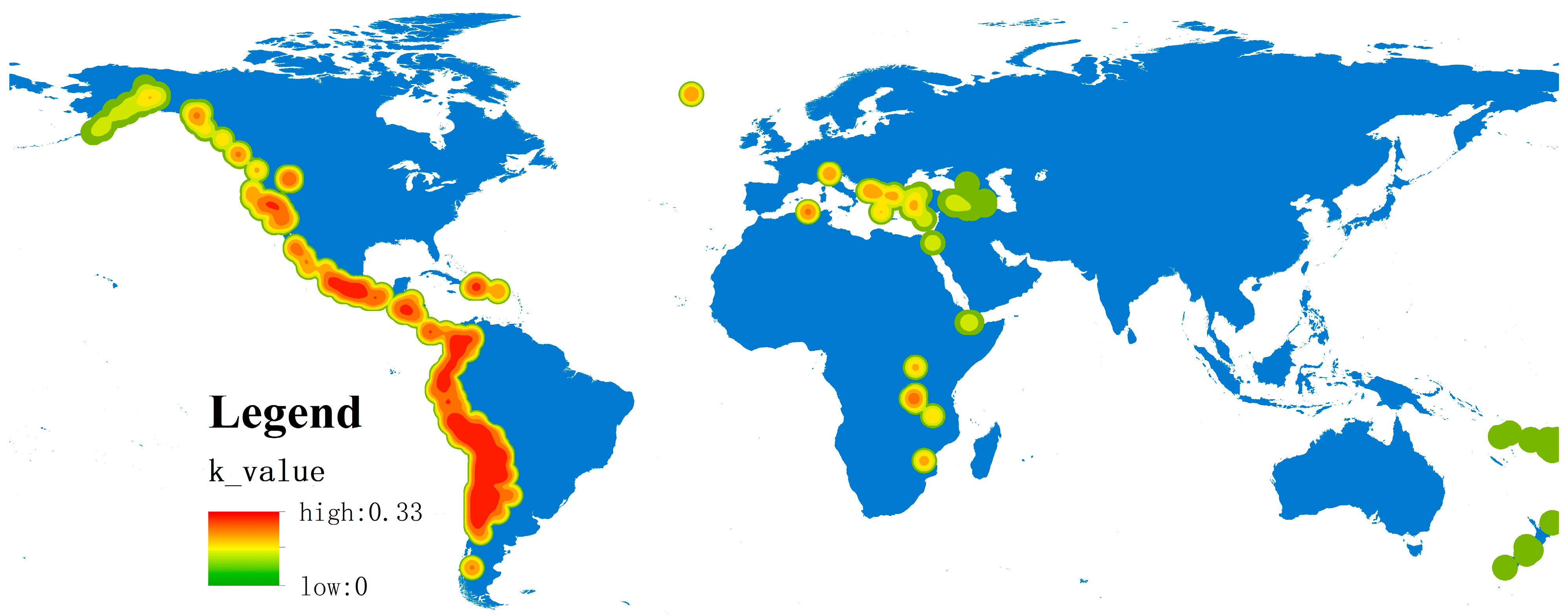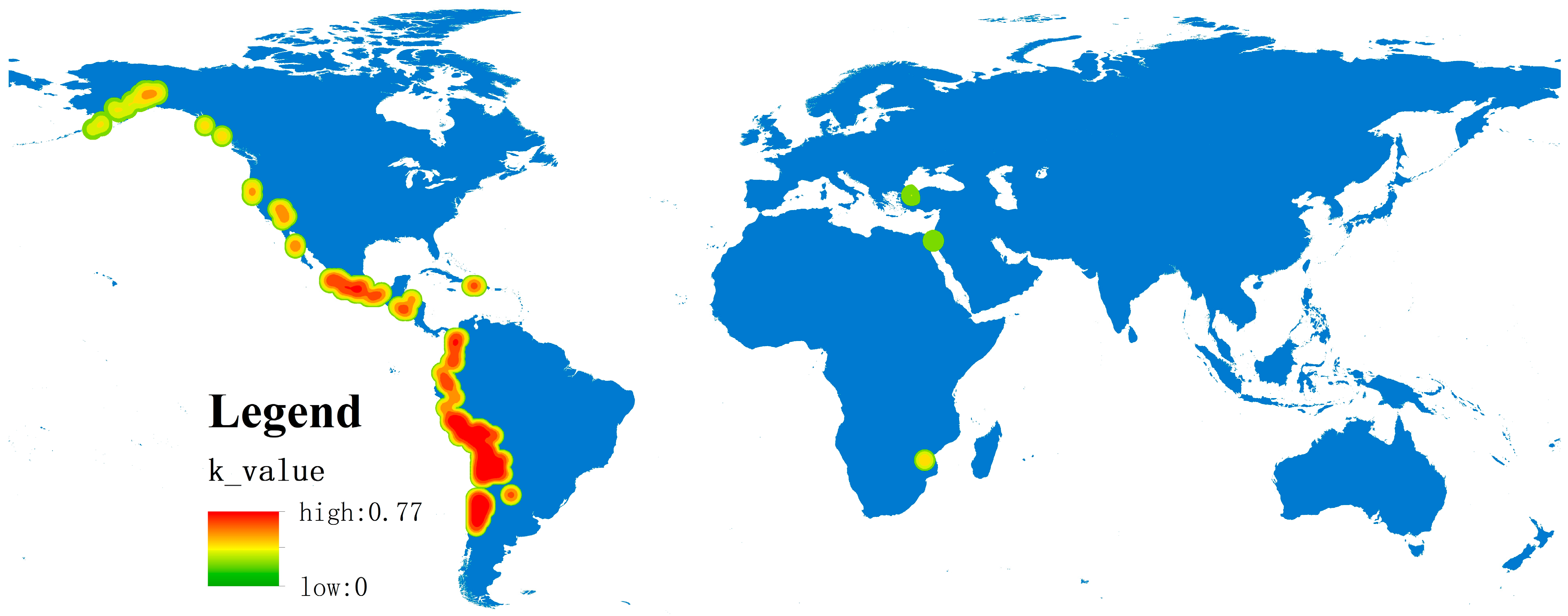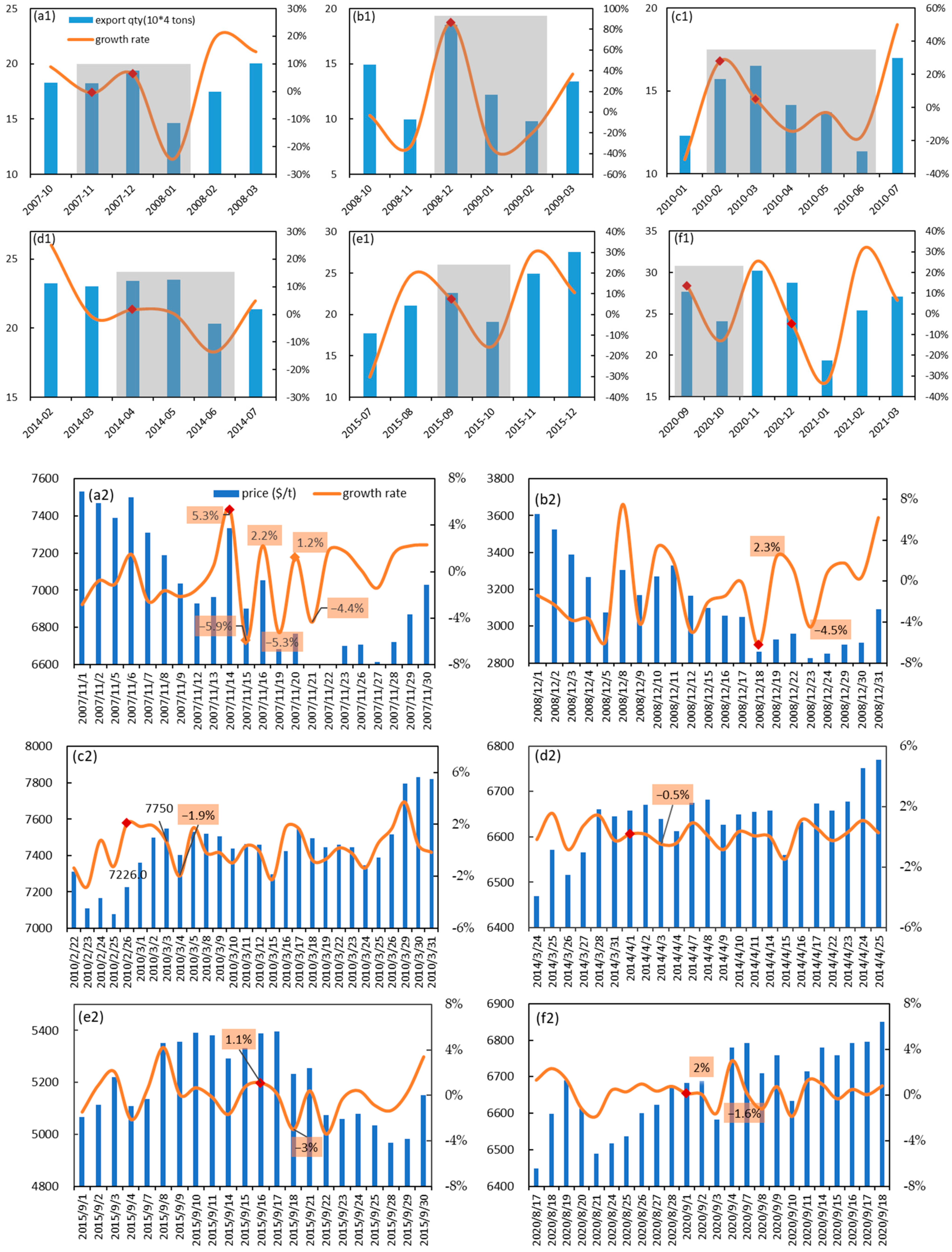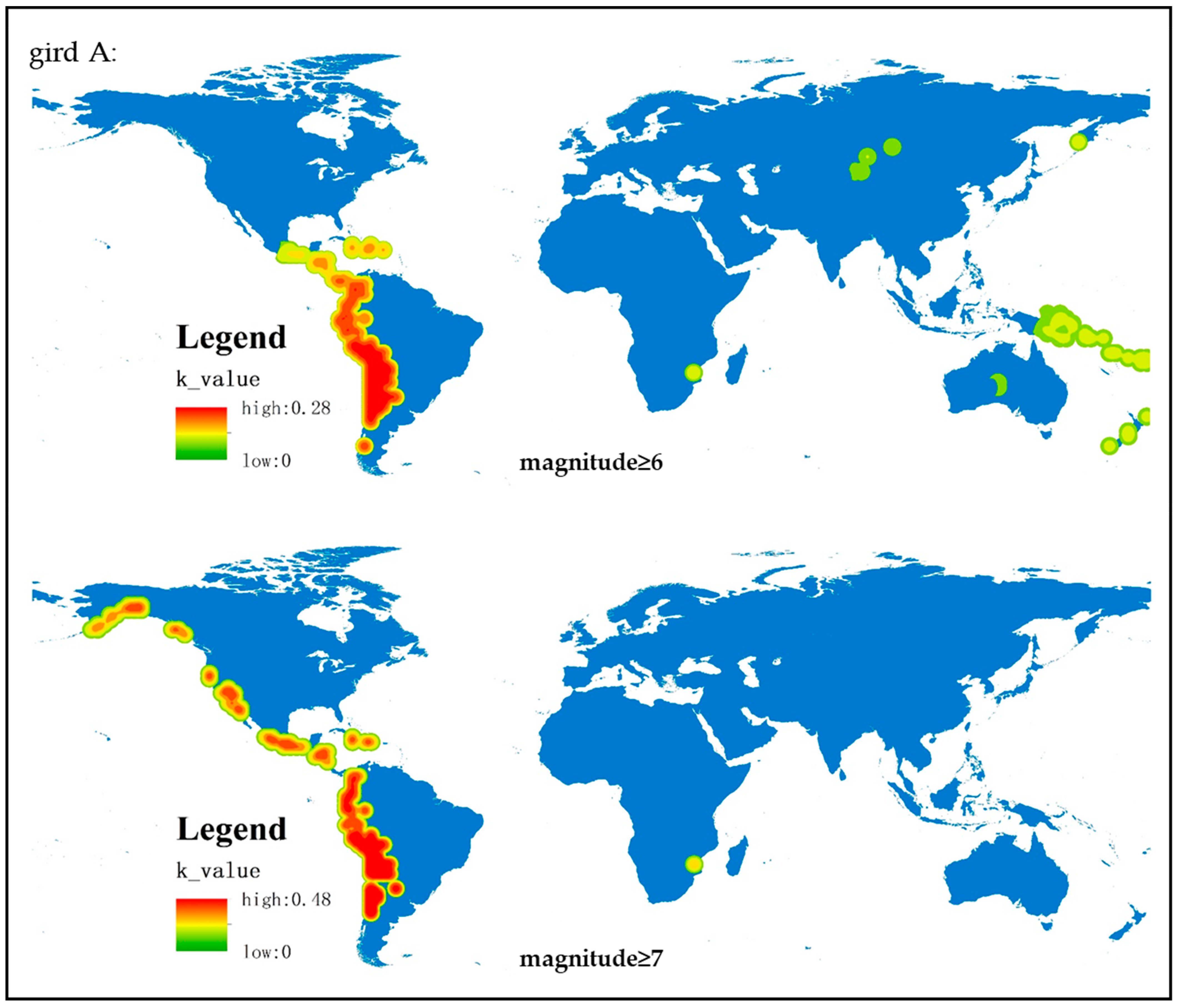Research on Spatiotemporal Heterogeneity of the Impact of Earthquakes on Global Copper Ore Supply Based on Geographically Weighted Regression
Abstract
1. Introduction
2. Research Methodology
2.1. Methods
2.1.1. Correlation Analysis
2.1.2. Geographically Weighted Regression Model (GWR)
2.1.3. Kernel Density Analysis
2.1.4. Earthquake Index
2.2. Data
3. Results
3.1. Spatial Correlation Analysis
3.2. Time Scale Impact: Chile and Peru
- (a)
- On 14 November 2007, a 7.7-magnitude earthquake occurred in the northern region of Chile, causing two deaths and 100 injuries. Many large copper mines, such as Chuquicamata SX-EW, Spence, Michelle/Lince, and Spence SX-EW, were located in the earthquake zone. Because of the impact of the earthquake, the mines were temporarily shut down and the road to a nearby copper mine in the capital, Santiago, was also blocked. On the same day, copper prices in London surged 5.3% from 6965 USD/ton to 7335 USD/ton and fell 5.9% the next day. Aftershocks occurred on the 15th and 20th, and copper prices showed a pattern of first rising and then falling, with the decline greater than the increase. Two months after the earthquake, Chile’s export volume decreased by 24% compared to the previous month, and it rebounded in February 2008;
- (b)
- On 18 December 2008, copper prices rose by 2.3% one day after the earthquake and fell by 4.5% four days later. After the earthquake, the export volume decreased continuously for two months and resumed growth in export volume in March. The 2008 financial crisis led to a global economic slowdown and a decrease in copper demand;
- (c)
- From February to March 2010, Chile experienced 8 earthquakes with a magnitude of 6 or higher. The copper mines were located far from the epicenter, but the earthquakes caused significant damage to infrastructure and had a long-term impact on copper production and transportation. On 27 February, an 8.8-magnitude earthquake occurred, accompanied by aftershocks on the 27th and 28th. The price of London copper continued to rise, with a cumulative increase of over 4%. It reached a high of 7550 USD per ton on March 3rd and fell back on March 4th. One month after the earthquake, the export volume decreased by 14% year-on-year and continued to decline for three months;
- (d)
- On 1 April 2014, a magnitude 8 earthquake occurred in the northern waters of Chile, with Cerro Colorado and Reina Hija nearby, but the company stated that it did not affect production. The cumulative increase in copper prices over the prior two days was 0.4%, and it quickly fell on the 3rd. The export volume was not immediately affected, with a 14% decrease in June;
- (e)
- On 16 September 2015, an 8.3-magnitude earthquake occurred in Chile, and Chile issued a tsunami warning for the entire coastal area, with Antofagasta plc (Venturer) accounting for 60%; Los Pelambres, owned by JX Nippon Mining&Metals with a production of 360,000, is located within the scope of the earthquake zone. LME 3-month copper rose 1.1% on the same day and fell on the 19th. The export volume in October decreased by 15% compared to the previous month;
- (f)
- On 1 and 6 September 2020, earthquakes of magnitude 6 or above occurred, causing copper prices to rise by 0.2% and fall by over 1%, showing a slight increase and a significant decline. One month after the Chilean earthquake in September and December, the export volume of copper ore decreased by 13% and 33%, respectively.
- (a)
- On 25 September 2013, a 7.1-magnitude earthquake occurred in the southern coastal area of Peru. The price rose for four consecutive days, with a cumulative increase of 1.6%. It fell back on 1 October. The export volume decreased by 19% in the month following the earthquake and rebounded in November;
- (b)
- On 24 August 2014, a 6.9-magnitude earthquake occurred in southern Peru, including the Toromocho copper mine project under China Aluminum Corporation in the southeast. The earthquake did not cause any losses to copper production, and LME prices did not rise. Shanghai copper rose slightly after opening, and the export of copper ore decreased by 25% the following month;
- (c)
- On 14 January 2018, a 7.1-magnitude earthquake occurred near the southwest coast of Peru, causing around 70 casualties. There were no reports of damage to the Cerro Verde, Cuajone, and Toquepala copper mines. One day after the earthquake, copper prices rose by 1.3%, but the increase on the 16th fell, and the export volume for the following month decreased by 9%;
- (d)
- On 1 March 2019, a magnitude 7 earthquake occurred in southeastern Peru, with few people at the epicenter and no casualties. The Lme copper price lacks data before and after the earthquake, with unknown price fluctuations and a 15% decrease in export volume;
- (e)
- On 26 May 2019, an 8-magnitude earthquake occurred in Chile. Lme copper prices lacked data before and after the earthquake, and the price fluctuations were unknown. The export volume decreased by 28% the following month;
- (f)
- On 31 May 2020, because of the impact of the pandemic, the production of copper mines in South America continued to be disrupted. The Peruvian border was completely closed, and land and water routes were suspended. Global pandemic prevention and control gradually took effect in the second half of the year, and the global economy gradually recovered. After the earthquake on June 1st, copper prices increased by 1.9%, and the export volume in the month following the earthquake decreased by 11%. Copper prices maintained an upward trend for ten consecutive days. Firstly, the earthquake caused copper prices to rise, and the Chinese wire and cable industry has driven demand. Global economic recovery has provided support for a significant increase in copper prices.
4. Discussion and Implications
4.1. Discussion
4.2. Implications
5. Final Remarks
Author Contributions
Funding
Institutional Review Board Statement
Informed Consent Statement
Data Availability Statement
Acknowledgments
Conflicts of Interest
References
- Chen, Q.; Yu, W.; Zhang, Y.; Tan, H. Resources-Industry ‘flying geese’ evolving pattern. Resour. Sci. 2015, 37, 871–882. (In Chinese) [Google Scholar]
- Chen, Q.; Yu, W.; Zhang, Y.; Tan, H. Mining development cycle theory and development trends in Chinese mining. Resour. Sci. 2015, 37, 891–899. (In Chinese) [Google Scholar]
- Chen, Q.; Zhang, Y.; Xing, J.; Long, T.; Zheng, G.; Wang, K.; Cui, B.; Qin, S. Methods of Strategic Mineral Resources Determination in China and Abroad. Acta Geosci. Sin. 2021, 42, 137–144. (In Chinese) [Google Scholar]
- Wang, K.; Chen, Q.; Zhang, Y.; Wang, F.; Xing, J.; Zheng, G.; Long, T.; Zhang, T.; Cui, B. A Discussion on a Comprehensive Evaluation Method for Overseas Copper Mine Investment Projects: A Case Study of Africa. Acta Geosci. Sin. 2021, 42, 229–235. (In Chinese) [Google Scholar]
- Sadeghi, Z.; Boyer, O.; Sharifzadeh, S.; Saeidi, N. A Robust Mathematical Model for Sustainable and Resilient Supply Chain Network Design: Preparing a Supply Chain to Deal with Disruptions. Complexity 2021, 2021, 9975071. [Google Scholar] [CrossRef]
- Li, D.; Jiao, J.; Wang, S.; Zhou, G. Supply Chain Resilience from the Maritime Transportation Perspective: A Bibliometric Analysis and Research Directions. Fundam. Res. 2023. [Google Scholar] [CrossRef]
- Zhao, Y.; Shuai, J.; Wang, J.; Shuai, C.; Ding, L.; Zhu, Y.; Zhou, N. Do critical minerals supply risks affect the competitive advantage of solar PV industry?—A comparative study of chromium and gallium between China, the United States and India. Environ. Impact Assess. 2023, 101, 107151. [Google Scholar] [CrossRef]
- Hatayama, H.; Tahara, K. Adopting an objective approach to criticality assessment: Learning from the past. Resour. Policy 2018, 55, 96–102. [Google Scholar] [CrossRef]
- Gutiérrez, D.; Paz, M.J.; Vite, A. Industrialization of natural resources as a strategy to avoid the natural resource curse: Case of Chilean copper. Extr. Ind. Soc. 2022, 11, 101133. [Google Scholar] [CrossRef]
- Botzen, W.J.W.; Deschenes, O.; Sanders, M. The Economic Impacts of Natural Disasters: A Review of Models and Empirical Studies. Rev. Environ. Econ. Policy 2019, 13, 167–188. [Google Scholar] [CrossRef]
- Singer, D.A. Future copper resources. Ore Geol. Rev. 2017, 86, 271–279. [Google Scholar] [CrossRef]
- Mao, J.; Xie, G.; Yuan, S. Current research progress and future trends of porphyry-skarn copper and granite-related tin polymetallic deposits in the Circum Pacific metallogenic belts. Acta Petrol. Sin. 2018, 34, 2501–2517. [Google Scholar]
- Lowell, J.D. Regional Characteristics of Porphyry Copper Deposits. Econ. Feology 1974, 69, 601–617. [Google Scholar] [CrossRef]
- Sun, W.; Wang, J.; Zhang, L.; Zhang, C.; Li, H.; Ling, M.; Ding, X.; Li, C.; Liang, H. The formation of porphyry copper deposits. Acta Geochim. 2017, 36, 9–15. [Google Scholar] [CrossRef]
- Codelco, Antofagasta Halt Operations after Chile Earthquake. Available online: https://www.mining.com/codelco-antofagasta-halt-operations-after-chile-earthquake/ (accessed on 1 May 2023).
- Copper Jumps after Chile Earthquake Temporarily Stops. Available online: https://www.ft.com/content/b834b374-5d29-11e5-9846-de406ccb37f2 (accessed on 1 May 2023).
- Forcellini, D. An expeditious framework for assessing the seismic resilience (SR) of structural configurations. Structures 2023, 56, 105015. [Google Scholar] [CrossRef]
- Nakaya, T. Local spatial interaction modelling based on the geographically weighted regression approach. GeoJournal 2001, 53, 347–358. [Google Scholar] [CrossRef]
- Amen, A.R.M.; Mustafa, A.; Kareem, D.A.; Hameed, H.M.; Mirza, A.A.; Szydlowski, M.; Saleem, B.K.M. Mapping of Flood-Prone Areas Utilizing GIS Techniques and Remote Sensing: A Case Study of Duhok, Kurdistan Region of Iraq. Remote Sens. 2023, 15, 1102. [Google Scholar] [CrossRef]
- Singh, N.; Tampubolon, D.; Yadavalli, V.S.S. Time Series Modelling of the Kobe-Osaka Earthquake Recordings. Int. J. Math. Math. Sci. 2015, 29, 467–479. [Google Scholar] [CrossRef]
- Bevacqua, E.; Maraun, D.; Haff, I.H.; Widmann, M.; Vrac, M. Multivariate statistical modelling of compound events via pair-copula constructions: Analysis of floods in Ravenna (Italy). Hydrol. Earth Syst. Sci. 2017, 21, 2701–2723. [Google Scholar] [CrossRef]
- Yin, J.; Yu, D.; Yin, Z.; Liu, M.; He, Q. Evaluating the impact and risk of pluvial flash flood on intra-urban road network: A case study in the city center of Shanghai, China. J. Hydrol. 2016, 537, 138–145. [Google Scholar] [CrossRef]
- Zhou, W.; Qiu, H.; Wang, L.; Pei, Y.; Tang, B.; Ma, S.; Yang, D.; Cao, M. Combining rainfall-induced shallow landslides and subsequent debris flows for hazard chain prediction. Catena 2022, 213, 106199. [Google Scholar] [CrossRef]
- Rahmati, O.; Zeinivand, H.; Besharat, M. Flood hazard zoning in Yasooj region, Iran, using GIS and multi-criteria decision analysis. Geomat. Nat. Hazards Risk 2016, 7, 1000–1017. [Google Scholar] [CrossRef]
- Souissi, D.; Zouhri, L.; Hammami, S.; Msaddek, M.H.; Zghibi, A.; Dlala, M. GIS-based MCDM—AHP modeling for flood susceptibility mapping of arid areas, southeastern Tunisia. Geocarto Int. 2020, 35, 991–1017. [Google Scholar] [CrossRef]
- Xu, H.; Ma, C.; Lian, J.; Xu, K.; Chaima, E. Urban flooding risk assessment based on an integrated k-means cluster algorithm and improved entropy weight method in the region of Haikou, China. J. Hydrol. 2018, 563, 975–986. [Google Scholar] [CrossRef]
- Wen, J.; Zhao, X.; Chang, C. The impact of extreme events on energy price risk. Energ. Econ. 2021, 99, 105308. [Google Scholar] [CrossRef]
- Schnebele, E.; Jaiswal, K.; Luco, N.; Nassar, N.T. Natural hazards and mineral commodity supply: Quantifying risk of earthquake disruption to South American copper supply. Resour. Policy 2019, 63, 101430. [Google Scholar] [CrossRef]
- Verschuur, J.; Koks, E.E.; Hall, J.W. Port disruptions due to natural disasters: Insights into port and logistics resilience. Transp. Res. Part D Transp. Environ. 2020, 85, 102393. [Google Scholar] [CrossRef]
- Kim, C.; Kim, S.W. A Mathematical Approach to Supply Complexity Management Efficiency Evaluation for Supply Chain. Math. Probl. Eng. 2015, 2015, 865970. [Google Scholar] [CrossRef]
- Da Silva, A.R.; de Sousa, M.D.R. Geographically Weighted Zero-Inflated Negative Binomial Regression: A general case for count data. Spat. Stat. 2023, 58, 100790. [Google Scholar] [CrossRef]
- Wu, B.; Li, R.; Huang, B. A geographically and temporally weighted autoregressive model with application to housing prices. Int. J. Geogr. Inf. Sci. 2014, 28, 1186–1204. [Google Scholar] [CrossRef]
- Savinova, E.; Evans, C.; Lèbre, É.; Stringer, M.; Azadi, M.; Valenta, R.K. Will global cobalt supply meet demand? The geological, mineral processing, production and geographic risk profile of cobalt. Resour. Conserv. Recycl. 2023, 190, 106855. [Google Scholar] [CrossRef]
- de Albuquerque, J.P.; Herfort, B.; Brenning, A.; Zipf, A. A geographic approach for combining social media and authoritative data towards identifying useful information for disaster management. Int. J. Geogr. Inf. Sci. 2015, 29, 667–689. [Google Scholar] [CrossRef]
- Xu, B.; Lin, B. Investigating spatial variability of CO2 emissions in heavy industry: Evidence from a geographically weighted regression model. Energ. Policy 2021, 149, 112011. [Google Scholar] [CrossRef]
- Xu, B.; Lin, B. Do we really understand the development of China’s new energy industry? Energ. Econ. 2018, 74, 733–745. [Google Scholar] [CrossRef]
- Xu, B.; Lin, B. Exploring the spatial distribution of distributed energy in China. Energ. Econ. 2022, 107, 105828. [Google Scholar] [CrossRef]
- Li, W.; Sun, W.; Li, G.; Jin, B.; Wu, W.; Cui, P.; Zhao, G. Transmission mechanism between energy prices and carbon emissions using geographically weighted regression. Energ. Policy 2018, 115, 434–442. [Google Scholar] [CrossRef]
- Petersen, M.D.; Harmsen, S.C.; Jaiswal, K.S.; Rukstales, K.S.; Luco, N.; Haller, K.M.; Mueller, C.S.; Shumway, A.M. Seismic Hazard, Risk, and Design for South America. Bull. Seismol. Soc. Am. 2018, 108, 781–800. [Google Scholar] [CrossRef]
- Zou, G.; Jian, R. A comprehensive review of the study on porphyry copper deposit. Yunnan Geol. 2011, 30, 387–393. (In Chinese) [Google Scholar]
- Ma, X.; Ji, Y.; Yuan, Y.; Van Oort, N.; Jin, Y.; Hoogendoorn, S. A comparison in travel patterns and determinants of user demand between docked and dockless bike-sharing systems using multi-sourced data. Transp. Res. Part A Policy Pract. 2020, 139, 148–173. [Google Scholar] [CrossRef]








| Time | Magnitude | Place | Related Reports |
|---|---|---|---|
| 12 November 1996 | 7.3 | Peru | Thirteen miners were trapped in the mining area, with water, electricity, and communication affected, roads blocked, and two bridges destroyed. |
| 13 June 2005 | 7.8 | Chile | Cerro Colorado is 10 km away from the epicenter, and road traffic was affected for two weeks after the disaster, causing damage to the factory. |
| 14 November 2007 | 7.7 | Chile North | Many large copper mines are also located in the earthquake zone, and more than ten mines were temporarily shut down due to power outages. |
| 27 February 2010 | 8.8 | Central and Southern Chile | The earthquake triggered a tsunami, with the epicenter still far from the northern region where copper mines are concentrated. However, the earthquake caused power supply disruptions, and four copper mines near the capital Santiago, including Los Bronces, El Soldado, El Tenien, and Andina, were shut down. |
| 3 January 2011 | 7.2 | Central Chile | The depth of the epicenter is 30 km, and the epicenter is about 590 km away from the capital city of Santiago, Chile. Mobile communication and power supply in the earthquake-stricken area have been interrupted. |
| 2 April 2014 | 8.2 | Northern Chilean waters | Occurred along the coast 86 km away from the northern Iquik mining area. The earthquake did not cause any casualties but caused multiple power outages in the northern region, and communication was also affected to some extent. |
| 26 May 2019 | 7.8 | Northern Peru | The depth of the epicenter is 100 km, and the epicenter is far from the main copper mining areas in Peru, with no mining areas affected. The nearby copper mine is Tantahuatay, but there have been no reports of damage. |
| 1 March 2019 | 7.2 | Southern Peru | The depth of the epicenter is 257 km, with a distance of 120 km from the mining area. The southern part of Peru is the main copper-producing area in Peru. Because of the scarcity of personnel near the epicenter, there have been no reports of casualties or property damage caused by the earthquake. |
| 26 December 2004 | 9.3 | West side of Sumatra, Indonesia | Unrecorded. |
| 8 September 2017 | 8.4 | Coastal Mexico | There are no major copper mines in the areas affected by the two earthquakes, so the impact on copper production in Mexico is relatively small, and the impact on its copper concentrate export business to China is relatively small. |
| 19 September 2017 | 7.1 | Morelos State, Central Mexico |
| Mag. | Earthquake Effect | Buffer (Miles) |
|---|---|---|
| 6–6.9 | Can destroy residential areas within a radius of 100 miles | 50 |
| 7–7.9 | Can cause serious damage to larger areas | 100 |
| 8–8.9 | Can destroy an area for hundreds of miles in a radius | 200 |
| 9 and above | Destroys an area thousands of miles around | 500 |
| Country | C_7 | Continent | Mines in Earthquake-Affected Areas | Mine Production (Ten Thousand Tons) |
|---|---|---|---|---|
| Chile | 0.66 | South America | Escondida, Collahuasi, El Teniente, Radomiro Tomic, Los Pelambres, Los Bronces, Chuquicamata, etc. | 470.97 |
| Peru | 0.59 | South America | Cerro Verde, Toromocho, Antapaccay, Marcona, etc. | 114.59 |
| Argentina | 0.68 | South America | San Jorge | 0 |
| Mexico | 0.32 | North America | Capela, El Aguila, Campo Morado | 0.56 |
| Bolivia | 0.63 | South America | San Vicente | 0.05 |
| Colombia | 0.47 | South America | El Roble | 0.68 |
| United States | 0.12 | North America | - | 0 |
| Ecuador | 0.51 | South America | Mirador | 12.5 |
| Indonesia | −0.1 | Asia | Grasberg, Wetar | 73.03 |
| Philippines | −0.1 | Asia | Atlas Toledo, Padcal | 4.51 |
| Total | 676.9 | |||
| Development Stage | Projects Number | Resource Reserves (Ore Quantity/Ten Thousand Tons) |
|---|---|---|
| Grassroots | 61 | 0 |
| Exploration | 106 | 150 |
| Target Outline | 81 | 30,940 |
| Reserves Development | 51 | 1,981,165 |
| Advanced Exploration | 12 | 60,600 |
| Prefeas/Scoping | 12 | 1,436,647 |
| Feasibility | 11 | 794,016 |
| Feasibility Started | 2 | 4500 |
| Feasibility Complete | 4 | 540,310 |
| Preproduction | 3 | 110 |
| Construction Planned | 2 | 87,080 |
| Operating | 71 | 9,324,633 |
| Satellite | 8 | 0 |
| Expansion | 8 | 6,558,280 |
| Limited Production | 3 | 2204 |
| Closed | 9 | 6030 |
| Total | 444 | 20,826,666.6 |
Disclaimer/Publisher’s Note: The statements, opinions and data contained in all publications are solely those of the individual author(s) and contributor(s) and not of MDPI and/or the editor(s). MDPI and/or the editor(s) disclaim responsibility for any injury to people or property resulting from any ideas, methods, instructions or products referred to in the content. |
© 2024 by the authors. Licensee MDPI, Basel, Switzerland. This article is an open access article distributed under the terms and conditions of the Creative Commons Attribution (CC BY) license (https://creativecommons.org/licenses/by/4.0/).
Share and Cite
Shang, C.; Chen, Q.; Wang, K.; Zhang, Y.; Zheng, G.; Zhang, D.; Xing, J.; Long, T.; Ren, X.; Kang, K.; et al. Research on Spatiotemporal Heterogeneity of the Impact of Earthquakes on Global Copper Ore Supply Based on Geographically Weighted Regression. Sustainability 2024, 16, 1487. https://doi.org/10.3390/su16041487
Shang C, Chen Q, Wang K, Zhang Y, Zheng G, Zhang D, Xing J, Long T, Ren X, Kang K, et al. Research on Spatiotemporal Heterogeneity of the Impact of Earthquakes on Global Copper Ore Supply Based on Geographically Weighted Regression. Sustainability. 2024; 16(4):1487. https://doi.org/10.3390/su16041487
Chicago/Turabian StyleShang, Chenghong, Qishen Chen, Kun Wang, Yanfei Zhang, Guodong Zheng, Dehui Zhang, Jiayun Xing, Tao Long, Xin Ren, Kun Kang, and et al. 2024. "Research on Spatiotemporal Heterogeneity of the Impact of Earthquakes on Global Copper Ore Supply Based on Geographically Weighted Regression" Sustainability 16, no. 4: 1487. https://doi.org/10.3390/su16041487
APA StyleShang, C., Chen, Q., Wang, K., Zhang, Y., Zheng, G., Zhang, D., Xing, J., Long, T., Ren, X., Kang, K., & Zhao, Y. (2024). Research on Spatiotemporal Heterogeneity of the Impact of Earthquakes on Global Copper Ore Supply Based on Geographically Weighted Regression. Sustainability, 16(4), 1487. https://doi.org/10.3390/su16041487








